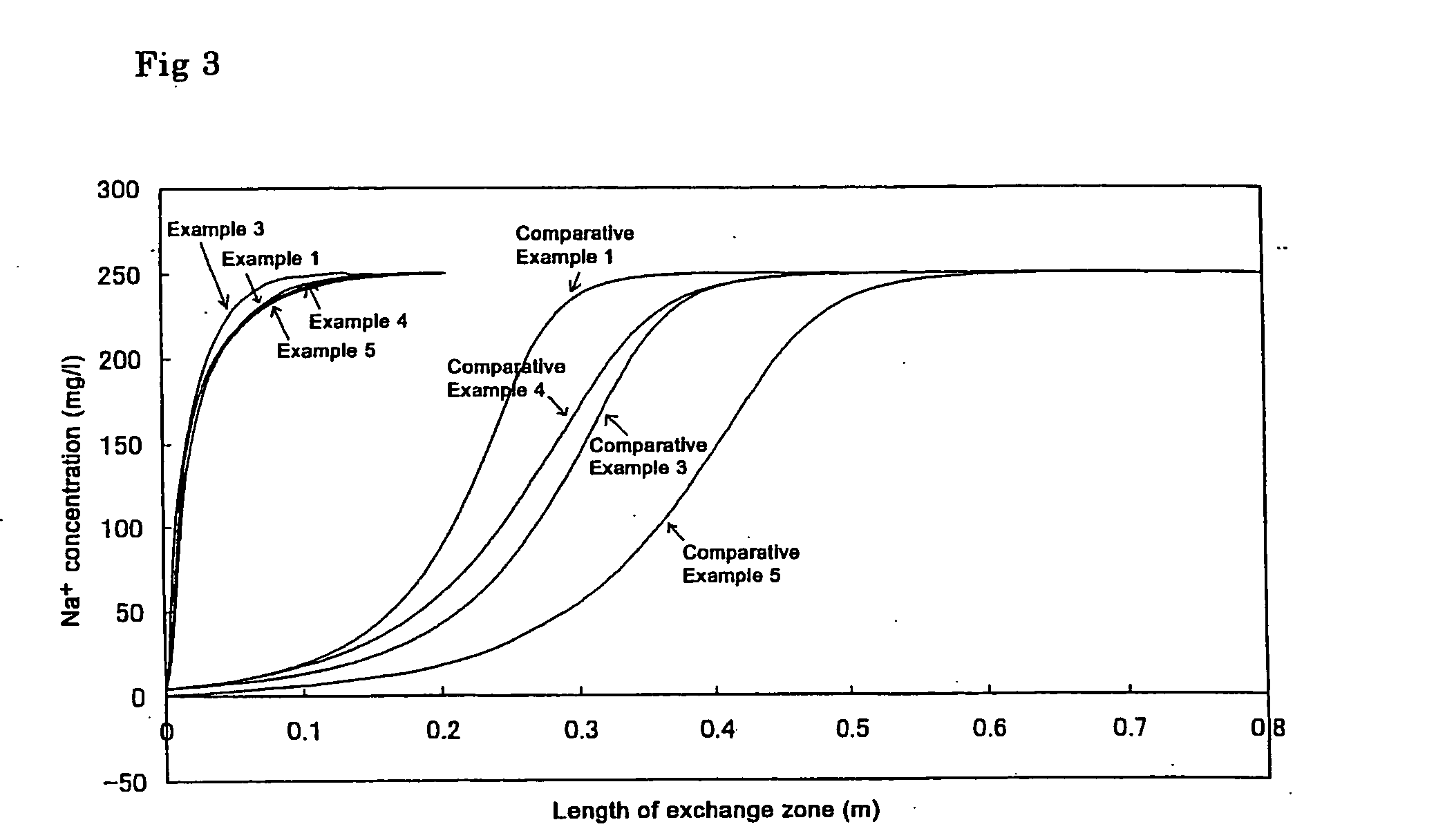Ion adsorption module and method for water treatment
a technology of adsorption module and adsorption channel, which is applied in the direction of cation exchanger materials, separation processes, filtration separation, etc., can solve the problems of limited application of ion exchange group and the like in the process at a large flow rate under a low pressure, leakage of a small amount of adsorbed ions, and low efficiency. , to achieve the effect of reducing the total length of the ion exchange zone, high efficiency and convenien
- Summary
- Abstract
- Description
- Claims
- Application Information
AI Technical Summary
Benefits of technology
Problems solved by technology
Method used
Image
Examples
example 1
(Preparation of Porous Ion Exchange Material)
[0042] Styrene (15.9 g), divinylbenzene (6.8 g), and sorbitan monooleate (10.3 g) were mixed and homogeneously dissolved. Next, potassium persulfate (0.60 g) was dissolved in deionized water (450 ml). The aqueous solution was added to the styrene / divinylbenzene / sorbitan monooleate mixture previously prepared. The resultant mixture was homogeneously emusified using a homogenizer. After the emulsification, the emulsion was fed into an autoclave. The internal atmosphere was sufficiently displaced with nitrogen and the autoclave was sealed. The emulsion was allowed to stand at 60° C. for 24 hours to carry out polymerization. After the polymerization, the reaction mixture was extracted with isopropanol for 18 hours using a Soxhlet extractor to remove the unreacted monomers and sorbitan monooleate, and dried overnight at 40° C. under reduced pressure. Tetrachloroethane (200 g) was added to an aliquot (5 g) of the porous material of the styren...
experiment 1
(Water Passage Experiment 1)
[0044] Sodium chloride was added to deionized water to prepare a simulated deionized water sample polluted at a low concentration. The life of the ion adsorption module A was tested by causing the water to pass through the module. The concentration of sodium chlodide in the simulated polluted deionized water sample caused to permeate through the ion adsorption module was 250 μg / l. The flow rate of water through the ion adsorption module was LV=30 m / hr. The amount of adsorbed sodium ions accounting for the total exchange capacity when the sodium concentration in the treated water exceeded 1 μg / l (sodium ion adsorption rate) was determined. The results are shown in FIG. 1. As is clear from FIG. 1, the adsorption rate of the porous cation exchange material was 83%. The length of the ion exchange zone was small as shown by the symbol a.
example 2
(Preparation 2 of Porous Ion Exchange Material)
[0046] A porous material comprising a p-chloromethylstyrene / divinylbenzene copolymer was produced in the same manner as in Example 1, except for using p-chloromethylstyrene (15.9 g) instead of styrene (15.9 g). Dioxane (200 g) was added to an aliquot (5 g) of the porous material and the mixture was heated at 80° C. for 30 minutes. After cooling to room temperature, an aqueous solution (65 g) of 30% trimethylamine was slowly added. The mixture was reacted at 50° C. for three hours and then allowed to stand overnight at room temperature. After the reaction, the porous material was removed from the reaction product, washed with acetone and then with water, and dried to obtain a porous anion exchange material. The ion exchange capacity of the porous material was 3.5 mg equivalent / g of the porous material on a dry basis. SIMS analysis confirmed that the porous material contained trimethylammonium groups uniformly introduced therein. The po...
PUM
| Property | Measurement | Unit |
|---|---|---|
| Length | aaaaa | aaaaa |
| Water holding capacity | aaaaa | aaaaa |
| Equivalent mass | aaaaa | aaaaa |
Abstract
Description
Claims
Application Information
 Login to View More
Login to View More - R&D
- Intellectual Property
- Life Sciences
- Materials
- Tech Scout
- Unparalleled Data Quality
- Higher Quality Content
- 60% Fewer Hallucinations
Browse by: Latest US Patents, China's latest patents, Technical Efficacy Thesaurus, Application Domain, Technology Topic, Popular Technical Reports.
© 2025 PatSnap. All rights reserved.Legal|Privacy policy|Modern Slavery Act Transparency Statement|Sitemap|About US| Contact US: help@patsnap.com


